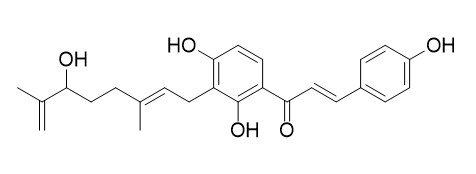Xanthoangelol B
Xanthoangelol B and its derivative PM-56 were shown to bind directly to SaeS and inhibit its histidine kinase activity, which suggests a possibility of a broad spectrum inhibitor of histidine kinases. Xanthoangelol B inhibited the phenylephrine-induced vasoconstriction most strongly, and the inhibitory mechanism of it on phenylephrine-induced vasoconstriction might involve the direct inhibition of smooth muscle functions through the reduction of [Ca2+]i elevation without affecting EDRF/NO production.
Inquire / Order:
manager@chemfaces.com
Technical Inquiries:
service@chemfaces.com
Tel:
+86-27-84237783
Fax:
+86-27-84254680
Address:
1 Building, No. 83, CheCheng Rd., Wuhan Economic and Technological Development Zone, Wuhan, Hubei 430056, PRC
Providing storage is as stated on the product vial and the vial is kept tightly sealed, the product can be stored for up to
24 months(2-8C).
Wherever possible, you should prepare and use solutions on the same day. However, if you need to make up stock solutions in advance, we recommend that you store the solution as aliquots in tightly sealed vials at -20C. Generally, these will be useable for up to two weeks. Before use, and prior to opening the vial we recommend that you allow your product to equilibrate to room temperature for at least 1 hour.
Need more advice on solubility, usage and handling? Please email to: service@chemfaces.com
The packaging of the product may have turned upside down during transportation, resulting in the natural compounds adhering to the neck or cap of the vial. take the vial out of its packaging and gently shake to let the compounds fall to the bottom of the vial. for liquid products, centrifuge at 200-500 RPM to gather the liquid at the bottom of the vial. try to avoid loss or contamination during handling.
Int Immunopharmacol.2024, 143(Pt 2):113486.
J Sep Sci.2018, 41(7):1682-1690
Cell Rep.2022, 39(1):110643.
J Med Food.2021, 24(2):151-160.
ACS Omega.2023, 8(36):32424-32431.
Food Chem.2019, 290:286-294
Sustainability2021, 13(23),12981.
Plant Growth Regulation2020, 90(2):383-392
Int J Mol Sci.2023, 24(17):13230.
Molecules.2022, 27(7):2360.
Related and Featured Products
Planta Med. 2001 Apr;67(3):230-5.
Artery relaxation by chalcones isolated from the roots of Angelica keiskei.[Pubmed:
11345693 ]
METHODS AND RESULTS:
An EtOAc-soluble fraction from a 50% EtOH extract of the roots of Angelica keiskei inhibited phenylephrine-induced vasoconstriction in rat aortic rings, while an EtOAc-insoluble fraction had no effect at 100 micrograms/ml. Five active substances isolated from the EtOAc-soluble fraction of the roots were identified as xanthoangelol (1), 4-hydroxyderricin (2), and Xanthoangelol B (3), xanthoangelol E (4) and xanthoangelol F (5), which inhibited phenylephrine-induced vasoconstriction at the concentrations of 10-100 micrograms/ml. It was found that xanthoangelol (1), 4-hydroxyderricin (2), and xanthoangelols E (4) and F (5) inhibited the phenylephrine-induced vasoconstriction through endothelium-dependent endothelium-derived relaxing factor (EDRF) production and/or nitric oxide (NO) production. Among the five chalcones, Xanthoangelol B (3) inhibited the phenylephrine-induced vasoconstriction most strongly, and it inhibited the phenylephrine-induced vasoconstriction in the presence or absence of endothelium and in the presence or absence of NG-monomethyl-L-arginine (L-NMMA) (an NO synthetase inhibitor). Furthermore, 4-hydroxyderricin (2) and Xanthoangelol B (3) at concentrations of 10-100 micrograms/ml concentration-dependently inhibited the elevation of intracellular free calcium [Ca2+]i induced by phenylephrine.
CONCLUSIONS:
These results demonstrate that compounds 1, 2, 4 and 5 inhibit phenylephrine-induced vasoconstriction through endothelium-dependent production of EDRF/NO and/or through the reduction of the [Ca2+]i elevation induced by phenylephrine. On the other hand, the inhibitory mechanism of compound 3 on phenylephrine-induced vasoconstriction might involve the direct inhibition of smooth muscle functions through the reduction of [Ca2+]i elevation without affecting EDRF/NO production.
J Med Chem. 2018 Dec 13;61(23):10473-10487.
Total Synthesis of Xanthoangelol B and Its Various Fragments: Toward Inhibition of Virulence Factor Production of Staphylococcus aureus.[Pubmed:
30388007 ]
As an alternative strategy to fight antibiotic resistance, two-component systems (TCSs) have emerged as novel targets. Among TCSs, master virulence regulators that control the expression of multiple virulence factors are considered as excellent antivirulence targets. In Staphylococcus aureus, virulence factor expression is tightly regulated by a few master regulators, including the SaeRS TCS.
METHODS AND RESULTS:
In this study, we used a SaeRS GFP-reporter system to screen natural compound inhibitors of SaeRS, and identified Xanthoangelol B 1, a prenylated chalcone from Angelica keiskei as a hit. We have synthesized 1 and its derivative PM-56 and shown that 1 and PM-56 both had excellent inhibitory potency against the SaeRS TCS, as demonstrated by various in vitro and in vivo experiments.
CONCLUSIONS:
As a mode of action, 1 and PM-56 were shown to bind directly to SaeS and inhibit its histidine kinase activity, which suggests a possibility of a broad spectrum inhibitor of histidine kinases.



